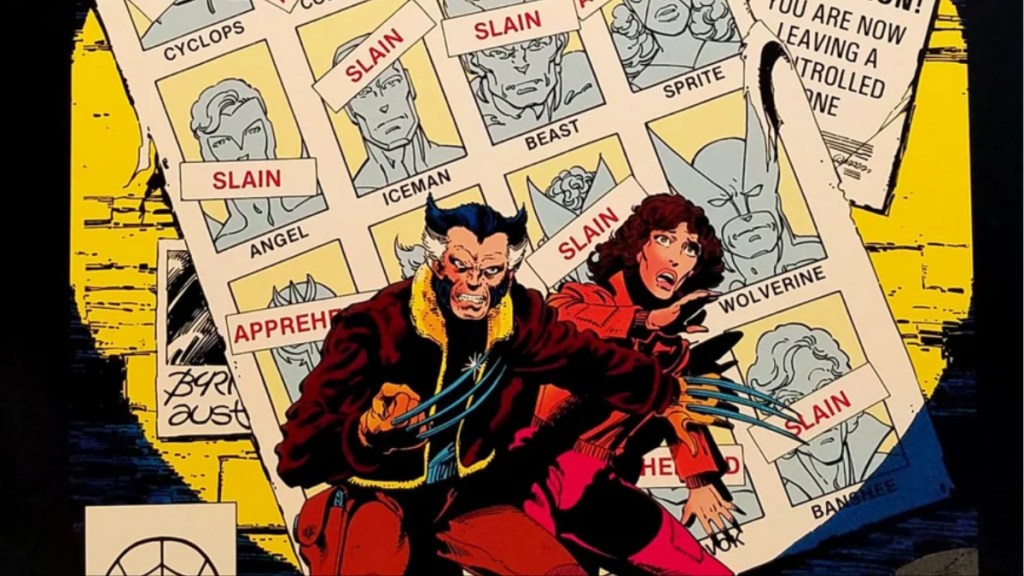The X-Men changed superhero comics forever. The greatest X-Men stories take the basics of superhero comics — good guys fighting bad guys — and add in a heaping helping of the real world. Comics had always dealt with real world issues, but the X-Men made their civil rights metaphor into an important part of every story. X-Men comics changed the comic industry in so many little ways, especially during the landmark 1974 to 1991 run of writer Chris Claremont. Claremont worked with some of the greatest artists of all time, and gave readers stories that were unlike anything in comics up to that point. Claremont’s work is full of revolutionary stories, but there’s one that started a trope that comics have run with for the last four decades — “Days of Future Past”.
Videos by ComicBook.com
Claremont worked with artist John Byrne on the story, which ran for two issues, Uncanny X-Men (Vol. 1) #141-142. “Days of Future Past” takes place in a dark future where the heroes have failed and the Earth is ruled by the Sentinels. The X-Men decide that the only way to save the world is to stop their future from happening, sending Kate Pryde back in time. “Days of Future Past” is a legendary story, and it set the standard for Marvel multiverse stories ever since. “Days of Future Past” changed comics for the better, and its fingerprints are all over pop culture.
“Days of Future Past” Never Goes Out of Style

Superhero multiverses have two eras, one pre-“Days of Future Past” and one post-“Days of Future Past”. DC’s multiverse set the standard for the pre-“Days of Future Past” superhero mutliverses — universes much like our own, but slightly different. However, one of these old universe sticks out and it’s Earth-X. Earth-X is a world where the Nazis won World War II, and the superhumans of the Earth band together to fight them. In many ways, Earth-X’s existence presaged where “Days of Future Past” would take multiverse comics. Earth-X revolved around an event happening differently and this idea would come to fruition with “Days of Future Past”. Now, I’m not saying that Earth-X is the first time we got an alternate history story in fiction in general, but it was the first time we got that in superhero comics, and that idea — of the world changing completely because of differing events — would soon become the main idea of superhero multiverses. “Days of Future Past” took this idea and made it into something undeniable.
RELATED: 10 Greatest X-Men Villains (And You Think One Is a Hero)
I don’t really need to go into the nuts and bolts of the story, if you’re reading this, you almost certainly know the story. What really strikes me about “Days of Future Past” is how much it inspired creators who came after it. The amount of stories that start out in a dystopian future in comics is manifold; every creator wanted to do their own version of “Days of Future Past”. Look at something like Kingdom Come. It’s completely different from “Days of Future Past”, yet it uses the same idea — a dark future created by the actions of the hero — to tell a story of hope. The Last Avengers Story and Avengers: Twilight are both comics that use this same idea. Age of Ultron? Kicks off in a universe that’s basically exactly the same as “Days of Future Past”, except it’s Ultron ruling the world instead of Sentinels. The Superman classic “Camelot Falls”? “DoFP” DNA. Armageddon 2001? Same. Earth X? Same again. Nearly every dark future of the X-Men takes the ideas of “Days of Future Past” and tweaks them. “Days of Future Past” changed comics forever.
“Days of Future Past” Has Become the Gold Standard

Sometimes, the dark alternate future stories can get a little tiring. We love these characters, and we’d prefer to see them in nice, happy futures. That’s the reason why alternate future stories like “Whatever Happened to the Man of Tomorrow?” are so great — they’re a happy ending. However, superhero stories are about the neverending battle; why would they have a wonderful future? Evil never actually dies. There have been plenty of bad alternate future stores — I brought up Age of Ultron, a story that has been panned since the moment it dropped — but there have also been dark future stories that are among the best comics of all time. “Days of Future Past” made all of those stories possible.
“Days of Future Past” is an awesome story. The writing and art are top notch, and that has helped its staying power. It takes the central metaphor of the X-Men and shows what happens when the monsters win. It’s good to see something like that; we need to remember that the mistakes of today can lead to the horrors of tomorrow (hint bloody hint, folks). “Days of Future Past” birthed an entire new corner of superhero comics, and the industry would be a sadder place without it. Always remember — The Terminator came out three years after “Days of Future Past”. I’m not saying that The Terminator was inspired by “Days of Future Past” — both of them are inspired by an Outer Limits episode — but “Days of Future Past” made the idea more popular than ever.









